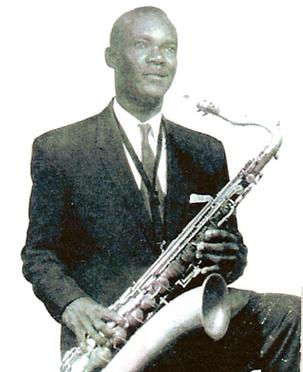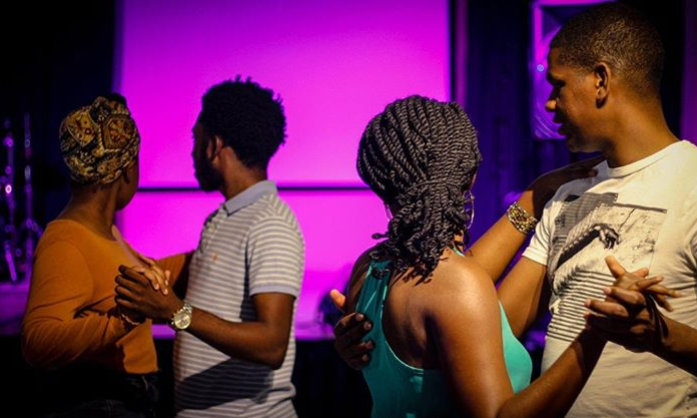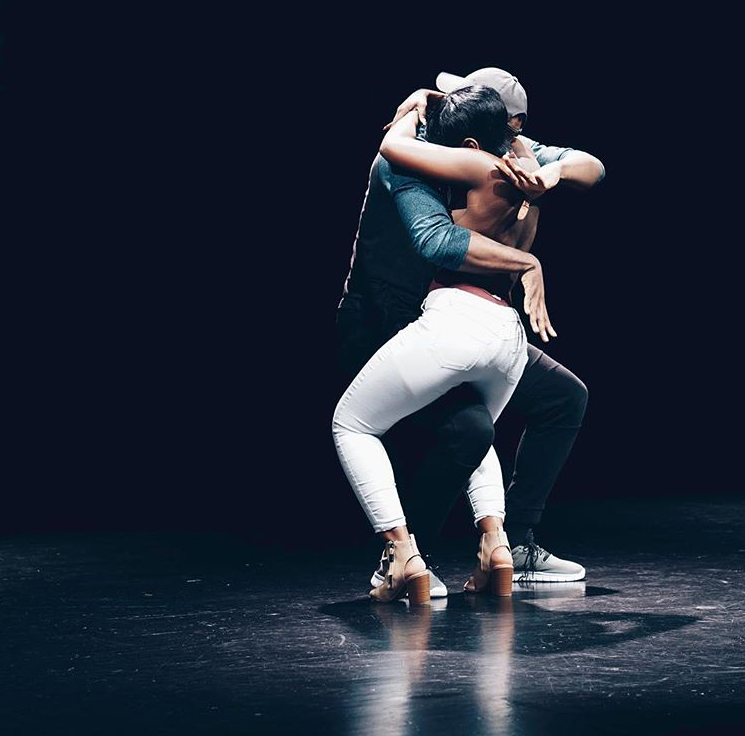What is Konpa?

What is Konpa?
Compas (Haitian Creole: Konpa) and also socially accepted by other french speaking creole islands as “Kompa”, is a dance music and modern méringue in Haiti. The genre was popularized following the 1955 creation of the band Conjunto International by Nemours Jean-Baptiste. Compas is the main music of many countries such as Dominica and the French Antilles, etc. Whether it is called zouk where French Antilles artists of Martinique and Guadeloupe have taken it or Compas in places where Haitian artists have toured, this méringue style is very influential in parts of Africa the Caribbean, Portugal, France, part of Canada, South, and North America.
The word “compás” in Spanish means “beat” or “rhythm,” and one of the most distinctive characteristics of Compas is the consistent pulsating beat tanbou, a trait common to many styles of Caribbean music. Compas direct literally means direct beat.

Konpa Dancing
The Dance style
The dance-style that accompanied konpa dirèk in the 1950s, was a two-step dance called kare (square). As a méringue, a ballroom dance, compas is danced in pairs. Sometimes partners dance holding each other tightly and romantically; in this case often most of the moves are made at the hips.

The New Era of Konpa : The Evolution
Gouyad & Urban Konpa
As Konpa music continues its evolution, so has the dance. While Konpa dancing has always been an animated dance for pairs, it now enters a new stylistic era to meet the demand of the early 2008s wave of konpa music.
DJs from the year 2000 and forward are mixing pre-mastered konpa music with sounds and/or acapella of Zouk, Kizomba/Semba, and even American R&B music to create new sounds for the young Konpa crowd. With so much fusion, Konpa now reluctantly opens its doors to two new Konpa dance styles, Urban Konpa, and Gouyad Dancing. Both styles are products of fused cross-culture music and in-house remixed music. When danced, dancers exaggerate the instruments they hear most for a more “attention to detail” type of dance.
Both styles are styles offered at KOTR Dance studio as special classes only or at pop-up workshops. Due to the subjective nature of the styles, KOTR Dance Studio wouldn’t typically teach these styles in their regular public classes.
Méringue-compas or cadence and its derivatives
The méringue-compas, deeply rooted in many countries, has been a strong influence and even called other names:
Some examples are zouk, coladeira, kizomba, cadence-lypso.
Click on each style below to expand and read futher.
Zouk was a brief experiment; an attempt to develop a proper local music that should lessen or even eradicate the méringue-kadans or compas influence from the French Antilles. When the MIDI technology came out, Kassav’ used it fully, creating new sound in both their fast zouk béton and kompa. The Antilleans were all over with zouk but as other bands from the Caribbean and Africa added the MIDI technology to their music, people got used to it. Because it was a jump up beat, the fast zouk béton faded away, and Antilleans continue to play and dance méringue-cadence or compas.
Kizomba is a popular music from Angola. It is a derivative of traditional Angolan Semba with the French Antilles compas. Although most music came from Africa, Angola has been receiving Haitian influence for years. For instance, great meringue queen Haitian Martha Jean-Claude lent her voice and music to the Angolan revolution; she came with the Cuban troops.[20] During the ’70s, Haitian bands and artists such as Coupe Cloue, Tabou Combo, Bossa combo, DP Express and Dominican bands like Exile One and Grammacks were popular in Africa. After many Cape Verdean emigrants arrived in France where they were exposed to compas music in the ’80s, they mixed it with a traditional Cape Verde style, the coladera, creating the Cabo Love, which is very similar to kizomba and typically sung in Cape Verdean Creole. It is this rhythm that was confused with kizomba, and was heard in Portugal when Eduardo Paim arrived there and released his first record with kizomba music. During the 80s-90s, French Antilles Kassav has toured the country with its compas, leaving influence. Lately, kizomba has been close to French Antilles and Cape Verdian light compas and sung generally in Portuguese. No wonder why kizomba shows that strong similarity with meringue-compas.[21]
n the 1970s with the frequent tours of the Sicot brothers, Exile One, and so many meringue bands, compas or cadence rampa has become very influential in several parts of the world, specifically the Caribbean. Its influence on the calypso gave rise to Soca, closer to cadence or compas.[16]
The calypsonian Lord Shorty of Trinidad was the first to really define his music and with “Indrani” in 1973 and “Endless Vibration” (not just the song but the entire album) in 1975, calypso music really took off in another direction. Later in 1975 Lord Shorty visited his good friend Maestro in Dominica where he stayed (at Maestro’s house) for a month while they visited and worked with local cadence or compas artists. You had Maestro experimenting with calypso and cadence. Sadly a year later Maestro would die in an accident in Dominica and his loss was palpably felt by Shorty, who penned “Higher World” as a tribute. In Dominica, Shorty had attended an Exile One performance of kadans, and collaborated with Dominica’s 1969 Calypso King, Lord Tokyo and two calypso lyricists, Chris Seraphine and Pat Aaron in the early 1970s, who wrote him some Creole lyrics. Soon after Shorty released a song, “Ou Petit”, with words like “Ou dee moin ou petit Shorty” (meaning “you told me you are small Shorty”). Soca’s development includes calypso, cadence/compas, and Indian musical instruments—particularly the dholak, tabla and dhantal—as demonstrated in Shorty’s classic compositions “Ïndrani” and “Shanti Om”.
There is a strong compas influence in Cape Verdean music. During the 1960s-1980s Haitian artists and bands such as Claudette & Ti Pierre, Tabou Combo and mostly Gesner Henry alias Coupe Cloue and the Dominican group Exile One were very popular in Africa. In addition, the French Antilles Kassav and other French Antillean musicians, whose main music is compas, toured Cabo island on various occasions. Many Cape Verdean artists feature compas. Talented Tito Paris dança mami Criola (1994) is a good example; this CD featured music close to Haiti Tabou Combo, Caribbean Sextet, Tropicana and French Antilles Kassav, etc. Cape Verdeans artists have been exposed to konpa in the US and France. Today the new generation of Cape Verdean artists features a light compas close to Haitian and French Antillean. Until Haitian musicians could tour Cabo verde, the tittle compas promoted as zouk by French Antillean artists would not be popular.
Webert Sicot, the originator of cadence known for his great virtuosity, mostly harmonic skills, was well appreciated in the Caribbean. This is why the term cadence was more popular than compas. Cadence-lypso is the Dominican kadans.
Cadence and calypso were the two dominant styles in Dominica hence the name cadence-lypso. The great majority of the songs are either calypso, reggae and mostly cadence or compas. If there is any fusion it should not be significant enough to be listed on album or CD covers. Finally cadence-lypso is danced the same way as compas.
Originally the word cadence or kadans was on album covers, whether grammacks or exile one. They featured calypso, reggae and mostly cadence: Grammacks: mediba (kadans), banana (sweet kadans), ou pa bon, (kadans), ou pitit (kadans), reggae down, disco live (kadans) this same tune is categorized as zouk retro by Deejay Zak (midlay kadans 11/24/2011) Exile one: akiyaka, gade deye…(Midnight) get ready 1997, etc.
Exile One, the leader of the word cadence-lypso, featured some reggae, calypso and mostly cadence music. For example: Album “Exile one – Gordon Henderson 40 volume 1” features 14 kadans out of 18 tunes. 1. Rosita 2. ba yo boi 3. jumbolo 4. jamais voir ca (calypso tune) 5. reflexion 6. n’homme ka batte n’homme 7. gadez deye 8. ah ta ta 9. Ico vole 10. pompilili 11. aki yaka 12. vivent les vacances aux antilles (calypso tune) 13. Ilyne (calypso tune) 14. nous travail pou ayen 15. cadence lypso 16. sexile 17. come here (reggae tune) 18. interlude. The song cadence lypso is a kadans tune. A third album “Collector kadance lypso” features twelve méringue cadence tunes. The album also features tunes from other kadans bands: 2. Rigrete (Midnight Groover), Serpent la (C Top 6), la vie vini plus raid (Belles combo) 9. Coq et perroquet (Liquid Ice) 12. mwen di ou fe (Black Affairs) 7. Chanson d’amour Ophelia (Exile one).
It is not sure whether the band’s intent was to fusion Trinidadian calypso with Haitian cadence or compas since little was done. The song “La Dominique” in the Album “Exile One Old School Session” could be an attempt, however, not often repeated. The band music repertoire is mostly cadence or compas with all the features of the style.The album “Exile one-Old school Session: Gree/Vert” features mostly méringue cadence or compas: 6 out of 8 tunes. 1) fete commune 2) torti 3) famille Creole 4) d’leau 5) sauvez riviere la and 7) Sylvie of course the band had its personality; it was a great kadans band. In the early 1970s, The full-horn section kadans band Exile One led by the talented Gordon Henderson was the first to use the synthesizers to their music that other young cadence or compas bands from Haiti (mini-jazz) and the French Antilles emulated in the 1970s. Exile One toured many places with kadans music: Japan, the Indian Ocean, Africa, North America, Europe, The Cape Verde islands. Other Dominica cadence bands included the Grammacks. Review Exile one CD 40 anniversary, Grammack collection 74–76 and others available at amazon music: Black Roots, Black Machine, Naked Feet, Belles Combo, Mantra, Black Affairs, Liquid Ice, Wafrikai, Midnighte Groovers and Milestone, while the most famous singers included Bill Thomas, Chubby Marc, Gordon Henderson, Linford John, Janet Azouz, Sinky Rabess, Tony Valmond, Jeff Joseph, Mike Moreau and Anthony Gussie. Ophelia Marie is a popular singer of cadence in the 1980s.

